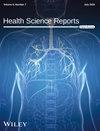Evaluation of the Susceptibility of Bangladeshi University Students to Gastroesophageal Reflux Disease (GERD) and Its Associated Factors: A Cross-Sectional Study
Abstract
Background and Aims
Gastroesophageal reflux disease (GERD) is a highly prevalent clinical condition all over the world. The study was conducted to determine the GERD prevalence among Bangladeshi university students using the frequency scale for the symptoms of gastroesophageal reflux disease (FSSG) score and to find out what factors are linked to the disease.
Methods
The study was based on descriptive cross-sectional analysis. After a comprehensive literature review, a questionnaire was developed with some pre-structured options kept in the sociodemographic, dietary, and lifestyle sections along with the FSSG parameters. The tool was disseminated among students of different universities in Bangladesh. After receiving the responses, all the data was analyzed using SPSS software (version 26.0).
Results
After scrutiny, 402 responses of the study participants were subjected to statistical analysis, and among participants, 57.2% (N = 230) were female and 42.8% (N = 172) were male. The GERD prevalence was 45.5% (N = 183), which indicated the FSSG score was more than 8 among 45.5% of the individuals. Logistic regression analysis revealed that eating beyond fullness (OR = 2.859, CI = 1.811–4.515), consumption of painkillers (OR = 2.237, CI = 1.370–3.653), anxiety (OR = 2.349, CI = 1.529–3.611), being stressed (OR = 2.255, CI = 1.456–3.494), quick eating habit (OR = 1.845, CI = 1.240–2.745), poor sleep quality (OR = 1.760, CI = 1.183–2.620), fast food consumption (OR = 1.613, CI = 1.082–2.404), eating sour and spicy food regularly (OR = 1.610, CI = 1.073–2.415), female gender (OR = 1.595, CI = 1.068–2.381), less interval between dinner and sleep (OR = 1.561, CI = 1.020–2.389), being alone most of the time (OR = 1.514, CI = 1.016–2.257), were significantly associated with the occurrence of GERD symptoms.
Conclusion
GERD symptoms were seen among a large number of university students. Various sociodemographic, dietary, and lifestyle-related factors had an impact on the disease; these contributing factors should be positively modified to alleviate the burden of GERD symptoms.


 求助内容:
求助内容: 应助结果提醒方式:
应助结果提醒方式:


